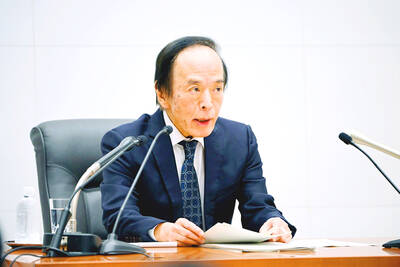Largan Precision Co (大立光), a major smartphone camera lens supplier to Apple Inc, might face limited earnings growth this year given the industry’s slow transition to higher-resolution lenses, Yuanta Securities Investment Consulting Co (元大投顧) Taipei-based analyst Jeff Pu (蒲得宇) said.
“With limited earnings upside and high market expectations, we continue to suggest investors take profit on the stock,” Pu wrote in a note to clients on Thursday last week.
Largan reported sales of NT$4 billion (US$127 million) for last month, up 66 percent year-on-year, but down 30 percent from December last year, falling below market expectations of a 20 percent decline month-on-month.
Pu said that Largan’s sales for last month came in below expectations due to lower demand for Apple iPhones, a smaller proportion of iPhone 6 Plus models in Largan’s shipment mix and weak demand from Chinese handset brands.
“February will be affected by fewer working days, and we don’t expect much of a recovery in March owing to the fast-falling number of iPhone [shipments],” said Pu, who maintained his “downgrade” rating on Largan shares and his price target of NT$2,650 for the stock.
Pu said that the camera specifications of the next-generation iPhone, dubbed iPhone 6S, will stay the same as the current iPhone 6 at 8-megapixels, limiting potential catalysts to push Largan’s stock price higher in the second half of the year.
Pu said that although the migration to 8-megapixel and 13-megapixel lenses would remain strong among Chinese vendors of mid-tier and low-end phones, upgrades to 16-megapixel and 20-megapixel lenses for flagship phones would be slow given the limited supply of CMOS sensors — used to convert light into electrons.
“On the other hand, we expect the specification migration in high-end models to be from new features, such as optical image stabilization and fast autofocus, which benefit module makers more than lens makers, in our view,” Pu said.
Data from Japanese research firm Techno Systems Research Co showed that Japan-based Sony Corp led the 2013 global CMOS image sensor market with a 33 percent share by sales value.
Sony, whose CMOS sensors are used in handsets made by Apple, Samsung Electronics Co Ltd and Huawei Technologies Co Ltd (華為), announced on Monday last week that it plans to increase its production capacity for stacked CMOS image sensors from its current level of about 60,000 wafers per month to about 80,000 wafers per month by the end of June next year.

Taiwan Semiconductor Manufacturing Co (TSMC, 台積電) last week recorded an increase in the number of shareholders to the highest in almost eight months, despite its share price falling 3.38 percent from the previous week, Taiwan Stock Exchange data released on Saturday showed. As of Friday, TSMC had 1.88 million shareholders, the most since the week of April 25 and an increase of 31,870 from the previous week, the data showed. The number of shareholders jumped despite a drop of NT$50 (US$1.59), or 3.38 percent, in TSMC’s share price from a week earlier to NT$1,430, as investors took profits from their earlier gains

In a high-security Shenzhen laboratory, Chinese scientists have built what Washington has spent years trying to prevent: a prototype of a machine capable of producing the cutting-edge semiconductor chips that power artificial intelligence (AI), smartphones and weapons central to Western military dominance, Reuters has learned. Completed early this year and undergoing testing, the prototype fills nearly an entire factory floor. It was built by a team of former engineers from Dutch semiconductor giant ASML who reverse-engineered the company’s extreme ultraviolet lithography (EUV) machines, according to two people with knowledge of the project. EUV machines sit at the heart of a technological Cold

TAIWAN VALUE CHAIN: Foxtron is to fully own Luxgen following the transaction and it plans to launch a new electric model, the Foxtron Bria, in Taiwan next year Yulon Motor Co (裕隆汽車) yesterday said that its board of directors approved the disposal of its electric vehicle (EV) unit, Luxgen Motor Co (納智捷汽車), to Foxtron Vehicle Technologies Co (鴻華先進) for NT$787.6 million (US$24.98 million). Foxtron, a half-half joint venture between Yulon affiliate Hua-Chuang Automobile Information Technical Center Co (華創車電) and Hon Hai Precision Industry Co (鴻海精密), expects to wrap up the deal in the first quarter of next year. Foxtron would fully own Luxgen following the transaction, including five car distributing companies, outlets and all employees. The deal is subject to the approval of the Fair Trade Commission, Foxtron said. “Foxtron will be

INFLATION CONSIDERATION: The BOJ governor said that it would ‘keep making appropriate decisions’ and would adjust depending on the economy and prices The Bank of Japan (BOJ) yesterday raised its benchmark interest rate to the highest in 30 years and said more increases are in the pipeline if conditions allow, in a sign of growing conviction that it can attain the stable inflation target it has pursued for more than a decade. Bank of Japan Governor Kazuo Ueda’s policy board increased the rate by 0.2 percentage points to 0.75 percent, in a unanimous decision, the bank said in a statement. The central bank cited the rising likelihood of its economic outlook being realized. The rate change was expected by all 50 economists surveyed by Bloomberg. The